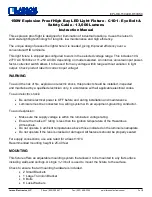
10 — English
WARNING:
The chain should never turn at idle. Turn the idle speed
screw “T” counterclockwise to reduce the idle RPM and
stop the chain, or contact a service dealer for adjustment
and discontinue use until the repair is made. Serious
personal injury can result from the chain turning at idle.
WARNING:
The chain will move around the guide bar when adjust-
ing the idle speed. Wear all protective clothing and keep
all bystanders, children, and pets at least 50 ft. away.
Make adjustments with the unit supported on a stable
surface so that the chain/guide bar does not contact the
ground or any object. Keep all parts of your body away
from the chain/guide bar and muffler. Failure to follow
these instructions could result in serious personal injury.
CHAIN TENSION
See Figures 16 - 17.
Stop the engine and remove the spark plug wire before
setting the chain tension. Make sure the guide bar nut
is loose to finger tight, turn the chain tensioning screw
clockwise to tension the chain. Refer to
Replacing the
Bar and Chain for additional information.
A cold chain is correctly tensioned when there is no slack
on the underside of the guide bar and the chain is snug,
but can be turned by hand without binding.
The chain must be re-tensioned whenever the flats on
the drive links hang out of the bar groove.
During normal operation, the temperature of the chain will
increase. The drive links of a correctly tensioned warm
chain will hang approximately .050 in. (1.25 mm) out of
the bar groove.
NOTE: New chains tend to stretch; check chain tension
frequently and tension as required.
CAUTION:
A chain tensioned while warm may be too tight upon
cooling. Check the “cold tension” before next use.
CHAIN OILER
See Figure 18.
Use Premium Bar and Chain Lubricant. It is designed for
chains and chain oilers and is formulated to perform over
a wide temperature range with no dilution required.
Remove the cap and carefully pour approximately 8 oz.
of the bar and chain lubricant into the chain oiler tank.
Replace the cap and tighten securely.
Check and refill the chain oiler tank every hour or every
time the engine is fueled.
NOTE: Do not use dirty, used, or otherwise contaminated
lubricants. Damage may occur to the oil pump, bar, or
chain.
CHAIN MAINTENANCE
See Figure 19.
WARNING:
The chain is very sharp; always wear protective gloves
when performing maintenance to the chain.
Use only the replacement low kickback chain specified for
this unit.
For smooth and fast cutting, the chain needs to be main-
tained properly. The chain requires sharpening when the
wood chips are small and powdery, the chain must be
forced through the wood during cutting, or the chain cuts
to one side. During maintenance of the chain, consider the
following:
Improper filing angle of the side plate can increase the
risk of a severe kickback.
Depth gauge (or raker clearance) setting determines the
height the cutter enters the wood and the size of the wood
chip that is removed. Too much clearance increases the
potential for kickback. Too little clearance decreases the
size of the wood chip thus decreasing the chain’s cutting
ability.
If cutter teeth have hit hard objects such as nails and
stones, or have been abraded by mud or sand on the
wood, have service dealer sharpen chain.
HOW TO SHARPEN THE CUTTERS
See Figures 20 - 23.
WARNING:
Improper chain sharpening increases the potential of
kickback. Failure to replace or repair damaged chain can
cause serious injury.
Be careful to file all cutters to the specified angles and to
the same length, as fast cutting can be obtained only when
all cutters are uniform.
Tighten the chain tension enough that the chain does not
wobble. Do all of your filing at the mid-point of the bar.
Wear gloves for protection.
Use a 5/32 in. diameter round file and holder.
Keep the file level with the top plate of the tooth. Do not
let the file dip or rock.
Using light but firm pressure, stroke towards the front
corner of the tooth. Lift file away from the steel on each
return stroke.
MAINTENANCE
Summary of Contents for GM15520
Page 37: ...13 NOTES NOTAS...















































